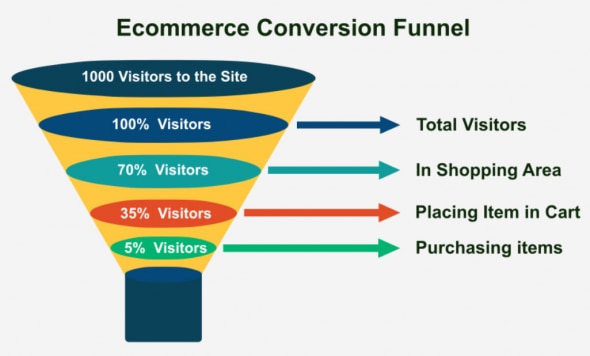In this article we’ll discuss how to increase your ecommerce website speed and conversions. It’s important to understand what elements influence the purchase decision so you can efficiently optimize your ecommerce website and boost conversion rates, and ultimately, sales.

A word on conversion rates
The conversion rate is the percentage of users who take a desired action. The archetypical example of conversion rate is the percentage of website visitors who buy something on the site.
Book a demo today to see GlobalDots is action.
Optimize cloud costs, control spend, and automate for deeper insights and efficiency.

Example: An ecommerce site is visited by 100,000 people during the month of April. During that month, 2,000 users purchased something from the site. Thus, the site’s conversion rate is 2,000/100,000 = 2%.
Conversion rates are always almost the same (2-3%) across most of the eCommerce sites below top 1000. Experts suggest that low conversion in general is due to the complexity of converting a viewer to a customer. Recent trends show that it’s getting harder to improve the conversion rates due to the situation of the web industry, given all the complexities of conversion decision, funnels, buyers stage, infrastructure and so on.
Here are some facts:
- 47% of people expect a web page to load in two seconds or less
- 40% will abandon a web page if it takes more than three seconds to load
- 52% of online shoppers claim that quick page loads are important for their loyalty to a site
- 14% will start shopping at a different site if page loads are slow
- 23% will stop shopping or even walk away from their computer
- 64% of shoppers who are dissatisfied with their site visit will go somewhere else to shop next time
The majority of businesses fail to create an efficient conversion rate optimization strategy. A website only has a 5-10 second window to make a good impression and start the dialogue between the product and the customer.
A site needs an effective system that enables marketers to make fast changes on the landing (and all other) pages, while securing the user experience at a highest level. Website performance is a key component (we’ll describe it in detail in the following chapters) to boost your conversions.
Web performance optimization is usually a “black box” for everyone outside IT departments. It means equipping your website with whatever gets it to load faster. Ideal time is less than 2 seconds, but many top brands keep losing customers, or customer interest due to bad performance, frequent downtimes, and overall lack of understanding of the web performance best practices.

Ecommerce conversion elements
If a website fails to make a good first impression, the user will leave in the first 15 seconds of landing on the site. Simple, isn’t it? Online store development goes into building the store, but despite the flawless design and efficiency of the programming code, the focus on creating a mind grabbing optimal user experience is needed.
In ecommerce, the number of sales is directly connected to the speed at which website content is being delivered.
Akamai, currently the world’s largest CDN services provider, ran a research in 2017 that went on to show that:
- A 100 millisecond slower webpage loading speed can result with a 7% drop in sales
- A 2 seconds slower webpage loading speed can almost double the number of visitors who end up abandoning their carts
- 53% of users who use smartphones to visit web stores won’t make the sale if the webpage takes more than 3 seconds to fully load
- The optimal loading time that ensures the highest number of sales is between 1.8 and 2.7 seconds.
- 28% of users won’t return to the same web store if they think it takes too long to load
- The webpages that lead to the highest number of sales loaded 26% faster than other webpages
- A 250 millisecond faster loading time proved to keep users from visiting a competitor web store
Performance has a direct impact on your website revenue, metrics influence brand perception, loyalty and visitor engagement.
Non-technical
These are the non-technical elements:
- Relevant & Compelling Headline the first thing your visitor will read to determine if she should keep reading or click the Back button to go to another website.
- Unique Selling Proposition include your unique selling proposition (USP) clearly on the webpage; what makes your business uniquely qualified to solve the prospects problems?
- Social Proof almost required to sell anything online because most people are very skeptical of websites. Social proof creates trust when done correctly.
- Irresistible Offer – The key to crafting an offer irresistible is to first think of every objection your prospects may have before purchasing your product or service.
- Reason to Act Now – There must be a real or perceived deadline to your offer in order to combat procrastination and increase your website conversion rates.
Non-technical elements are those focused mostly on the actual marketing and sales process, user design and consumer psychology. They are crucial in the selling process. However, without properly implemented technical elements your conversion rates will also suffer.
Technical
The key technical element to consider is website speed.
Page speed measures the time it takes the content on a URL to load. Site speed, on the other hand, represents how your site is performing overall. It’s scored by services like Google PageSpeed Insights which look at various load times on your site in aggregate.
Both paid and organic search engine channels will also penalize a slow loading site.
With paid search, slow landing pages lower your Google AdWords Quality Score—which means a higher cost-per-click.
Search engine optimization (SEO) experts will also tell you that slow pages hurt organic rankings. Google made it official in their latest “Speed Update.” As of July 2018, page speed is now a ranking factor for mobile searches, too.
There are several ways to increase your website speed:
- Leverage a Content Delivery Network (CDN) – Given the increasingly international nature of ecommerce, leveraging a CDN — or multi-CDNs — is a non-negotiable ingredient your platform should provide and optimize regularly.
- Compress and reduce images – Images take up 60% of an average storefront page, JPEGs take longer to respond than other content types (except flash) and they are still making a majority of requests for image type, followed by PNGs and GIFs.
- Use caching – Caching is a mechanism for the temporary storage of web pages in order to reduce bandwidth and improve performance. When a visitor arrives at your website the cached version will be served up unless it has changed since the last cache. This saves server time and makes things altogether faster.
- Use fewer round-trips – Minimize the number of “round trips” to the server by combining multiple files. For example, instead of accessing multiple JavaScript files separately, first combine them into a single file and then access the server
- Monitor site speed – Check the speed of your ecommerce site periodically. If a page is taking more than 3 seconds to load, it likely needs improving.
- Optimize for mobile – One eCommerce channel you can’t afford to ignore is mobile. That’s because more people use mobile devices than desktops. It’s also a key channel for researching products and services.
Conclusion
Improve ecommerce conversion rates takes time and effort. We have looked at some ways you can increase your website’s speed to improve conversions. In the next article, we’ll take a deeper look at key performance metrics that influence conversions, and how you can optimize those metrics to further boost conversions and revenue.
If you have any questions, contact us today to help you out with your performance and security needs.






